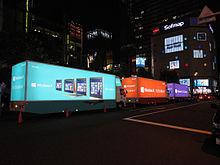Marketing:
In 2004, Microsoft commissioned research firms to do independent studies comparing the total cost of ownership (TCO) of Windows Server 2003 to Linux;
the firms concluded that companies found Windows easier to administrate than Linux, thus those using Windows would administrate faster resulting in lower costs for their company (i.e. lower TCO).
This spurred a wave of related studies; a study by the Yankee Group concluded that upgrading from one version of Windows Server to another costs a fraction of the switching costs from Windows Server to Linux.
Although companies surveyed noted the increased security and reliability of Linux servers and concern about being locked into using Microsoft products.
Another study, released by the Open Source Development Labs, claimed that the Microsoft studies were "simply outdated and one-sided" and their survey concluded that the TCO of Linux was lower due to Linux administrators managing more servers on average and other reasons.
As part of the "Get the Facts" campaign, Microsoft highlighted the .NET trading platform that it had developed in partnership with Accenture for the London Stock Exchange, claiming that it provided "five nines" reliability. After suffering extended downtime and unreliability
the LSE announced in 2009 that it was planning to drop its Microsoft solution and switch to a Linux-based one in 2010.
In 2012, Microsoft hired a political pollster named Mark Penn, whom the New York Times called "famous for bulldozing" his political opponents
as Executive Vice-President, Advertising and Strategy. Penn created a series of negative ads targeting one of Microsoft's chief competitors, Google. The ads, called "Scroogled", attempt to make the case that Google is "screwing" consumers with search results rigged to favor Google's paid advertisers, that Gmail violates the privacy of its users to place ad results related to the content of their emails and shopping results which favor Google products. Tech publications like Tech Crunch have been highly critical of the ad campaign,
while Google employees have embraced it.
Layoffs:
In July 2014, Microsoft announced plans to lay off 18,000 employees. Microsoft employed 127,104 people as of June 5, 2014, making this about a 14 percent reduction of its workforce as the biggest Microsoft lay off ever. This included 12,500 professional and factory personnel. Previously, Microsoft has laid off 5,800 jobs in 2009 in line with US financial crisis.
In September 2014, Microsoft laid off 2,100 people, including 747 people in the Seattle-Redmond area, where the company is headquartered. The firings came as a second wave of the layoffs that were previously announced. This brings the total number to over 15,000 out of the 18,000 expected cuts.
In October 2014, Microsoft revealed that it was almost done with the elimination of 18,000 employees which was its largest ever layoff sweep.
In July 2015, Microsoft announced another 7,800 job cuts in the next several months.
In May 2016, Microsoft announced another 1,850 job cuts mostly in (Nokia) mobile phone division. As a result, the company will record an impairment and restructuring charge of approximately $950 million, of which approximately $200 million will relate to severance payments.


No comments:
Post a Comment